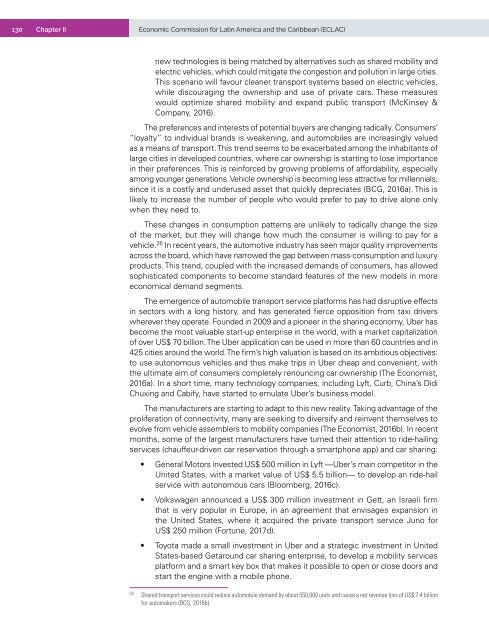Foreign Direct Investment in Latin America and the Caribbean 2017
This publication sets out and analyses the main foreign direct investment (FDI) trends in the countries of Latin America and the Caribbean. The 2017 edition shows that the region is at a difficult juncture. FDI inflows declined by 7.9% in 2016, to US$ 167.043 billion, representing a cumulative fall of 17.0% since the peak in 2011. The fall in commodity prices continues to affect investments in natural resources, sluggish economic growth in several countries has slowed the flow of market-seeking capital, and the global backdrop of technological sophistication and expansion of the digital economy has concentrated transnational investments in developed economies.
This publication sets out and analyses the main foreign direct investment (FDI) trends in the countries of Latin America and the Caribbean. The 2017 edition shows that the region is at a difficult juncture. FDI inflows declined by 7.9% in 2016, to US$ 167.043 billion, representing a cumulative fall of 17.0% since the peak in 2011. The fall in commodity prices continues to affect investments in natural resources, sluggish economic growth in several countries has slowed the flow of market-seeking capital, and the global backdrop of technological sophistication and expansion of the digital economy has concentrated transnational investments in developed economies.
Create successful ePaper yourself
Turn your PDF publications into a flip-book with our unique Google optimized e-Paper software.
130 Chapter II Economic Commission for Lat<strong>in</strong> <strong>America</strong> <strong>and</strong> <strong>the</strong> <strong>Caribbean</strong> (ECLAC)<br />
new technologies is be<strong>in</strong>g matched by alternatives such as shared mobility <strong>and</strong><br />
electric vehicles, which could mitigate <strong>the</strong> congestion <strong>and</strong> pollution <strong>in</strong> large cities.<br />
This scenario will favour cleaner transport systems based on electric vehicles,<br />
while discourag<strong>in</strong>g <strong>the</strong> ownership <strong>and</strong> use of private cars. These measures<br />
would optimize shared mobility <strong>and</strong> exp<strong>and</strong> public transport (McK<strong>in</strong>sey &<br />
Company, 2016).<br />
The preferences <strong>and</strong> <strong>in</strong>terests of potential buyers are chang<strong>in</strong>g radically. Consumers’<br />
“loyalty” to <strong>in</strong>dividual br<strong>and</strong>s is weaken<strong>in</strong>g, <strong>and</strong> automobiles are <strong>in</strong>creas<strong>in</strong>gly valued<br />
as a means of transport. This trend seems to be exacerbated among <strong>the</strong> <strong>in</strong>habitants of<br />
large cities <strong>in</strong> developed countries, where car ownership is start<strong>in</strong>g to lose importance<br />
<strong>in</strong> <strong>the</strong>ir preferences. This is re<strong>in</strong>forced by grow<strong>in</strong>g problems of affordability, especially<br />
among younger generations. Vehicle ownership is becom<strong>in</strong>g less attractive for millennials,<br />
s<strong>in</strong>ce it is a costly <strong>and</strong> underused asset that quickly depreciates (BCG, 2016a). This is<br />
likely to <strong>in</strong>crease <strong>the</strong> number of people who would prefer to pay to drive alone only<br />
when <strong>the</strong>y need to.<br />
These changes <strong>in</strong> consumption patterns are unlikely to radically change <strong>the</strong> size<br />
of <strong>the</strong> market, but <strong>the</strong>y will change how much <strong>the</strong> consumer is will<strong>in</strong>g to pay for a<br />
vehicle. 26 In recent years, <strong>the</strong> automotive <strong>in</strong>dustry has seen major quality improvements<br />
across <strong>the</strong> board, which have narrowed <strong>the</strong> gap between mass-consumption <strong>and</strong> luxury<br />
products. This trend, coupled with <strong>the</strong> <strong>in</strong>creased dem<strong>and</strong>s of consumers, has allowed<br />
sophisticated components to become st<strong>and</strong>ard features of <strong>the</strong> new models <strong>in</strong> more<br />
economical dem<strong>and</strong> segments.<br />
The emergence of automobile transport service platforms has had disruptive effects<br />
<strong>in</strong> sectors with a long history, <strong>and</strong> has generated fierce opposition from taxi drivers<br />
wherever <strong>the</strong>y operate. Founded <strong>in</strong> 2009 <strong>and</strong> a pioneer <strong>in</strong> <strong>the</strong> shar<strong>in</strong>g economy, Uber has<br />
become <strong>the</strong> most valuable start-up enterprise <strong>in</strong> <strong>the</strong> world, with a market capitalization<br />
of over US$ 70 billion. The Uber application can be used <strong>in</strong> more than 60 countries <strong>and</strong> <strong>in</strong><br />
425 cities around <strong>the</strong> world. The firm’s high valuation is based on its ambitious objectives:<br />
to use autonomous vehicles <strong>and</strong> thus make trips <strong>in</strong> Uber cheap <strong>and</strong> convenient, with<br />
<strong>the</strong> ultimate aim of consumers completely renounc<strong>in</strong>g car ownership (The Economist,<br />
2016a). In a short time, many technology companies, <strong>in</strong>clud<strong>in</strong>g Lyft, Curb, Ch<strong>in</strong>a’s Didi<br />
Chux<strong>in</strong>g <strong>and</strong> Cabify, have started to emulate Uber’s bus<strong>in</strong>ess model.<br />
The manufacturers are start<strong>in</strong>g to adapt to this new reality. Tak<strong>in</strong>g advantage of <strong>the</strong><br />
proliferation of connectivity, many are seek<strong>in</strong>g to diversify <strong>and</strong> re<strong>in</strong>vent <strong>the</strong>mselves to<br />
evolve from vehicle assemblers to mobility companies (The Economist, 2016b). In recent<br />
months, some of <strong>the</strong> largest manufacturers have turned <strong>the</strong>ir attention to ride-hail<strong>in</strong>g<br />
services (chauffeur-driven car reservation through a smartphone app) <strong>and</strong> car shar<strong>in</strong>g:<br />
• General Motors <strong>in</strong>vested US$ 500 million <strong>in</strong> Lyft —Uber’s ma<strong>in</strong> competitor <strong>in</strong> <strong>the</strong><br />
United States, with a market value of US$ 5.5 billion— to develop an ride-hail<br />
service with autonomous cars (Bloomberg, 2016c).<br />
• Volkswagen announced a US$ 300 million <strong>in</strong>vestment <strong>in</strong> Gett, an Israeli firm<br />
that is very popular <strong>in</strong> Europe, <strong>in</strong> an agreement that envisages expansion <strong>in</strong><br />
<strong>the</strong> United States, where it acquired <strong>the</strong> private transport service Juno for<br />
US$ 250 million (Fortune, <strong>2017</strong>d).<br />
• Toyota made a small <strong>in</strong>vestment <strong>in</strong> Uber <strong>and</strong> a strategic <strong>in</strong>vestment <strong>in</strong> United<br />
States-based Getaround car shar<strong>in</strong>g enterprise, to develop a mobility services<br />
platform <strong>and</strong> a smart key box that makes it possible to open or close doors <strong>and</strong><br />
start <strong>the</strong> eng<strong>in</strong>e with a mobile phone.<br />
26<br />
Shared transport services could reduce automobile dem<strong>and</strong> by about 550,000 units <strong>and</strong> cause a net revenue loss of US$ 7.4 billion<br />
for automakers (BCG, 2016b).


















